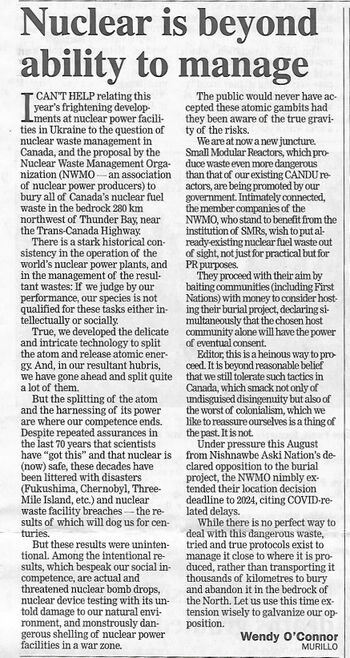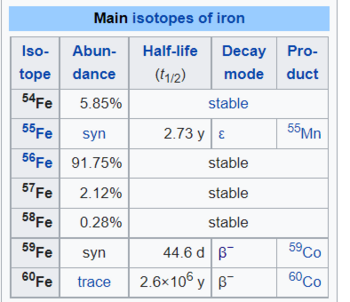Talk:Nuclear waste management: Difference between revisions
(→Nuclear Waste is Unmanageable: add link to Nuclear Reader) |
|||
| Line 30: | Line 30: | ||
“The HI-STORE CIS facility occupies less than the top 30 feet of the earth’s crust. Industrial activities such as mining of potash or extraction of hydrocarbons from the land, which occurs >1000 feet below-the-surface, will be entirely unaffected by the HI-STORE installation.“<br> | “The HI-STORE CIS facility occupies less than the top 30 feet of the earth’s crust. Industrial activities such as mining of potash or extraction of hydrocarbons from the land, which occurs >1000 feet below-the-surface, will be entirely unaffected by the HI-STORE installation.“<br> | ||
= | =Non-fuel waste= | ||
'''Question''' in the FaceBook group [https://www.facebook.com/groups/2081763568746983/posts/3111046639151999 Renewable vs Nuclear]<br> | '''Question''' in the FaceBook group [https://www.facebook.com/groups/2081763568746983/posts/3111046639151999 Renewable vs Nuclear]<br> | ||
"all the stuff on the primary loop. Pipes, pumps, wiring, blah blah. Obviously there is going to be mechanical and chemical wear on parts and they will need to be replaced like any power plant relying on heat -> steam -> turbine -> generator process. Parts will be be additionally exposed to neutrons and presumably undergo nuclear reactions and I assume some of those reactions will compromise their mechanical properties... eventually. How big of a deal is this? Is it slow, fast? What is the balance of fuel waste to non-fuel waste? Where do these parts go?"<br> | "all the stuff on the primary loop. Pipes, pumps, wiring, blah blah. Obviously there is going to be mechanical and chemical wear on parts and they will need to be replaced like any power plant relying on heat -> steam -> turbine -> generator process. Parts will be be additionally exposed to neutrons and presumably undergo nuclear reactions and I assume some of those reactions will compromise their mechanical properties... eventually. How big of a deal is this? Is it slow, fast? What is the balance of fuel waste to non-fuel waste? Where do these parts go?"<br> | ||
Revision as of 09:08, 5 September 2022
Nuclear Waste is Unmanageable
From the Chronical Journal:
see Fig.1
Response:
From Nuclear Reader, Ch.8 Radioactive Waste:
"there is no plan for long term storage of radioactive waste."
Response:
Risk of Leaking Canisters
From the San Onofre Safety Website:
https://sanonofresafety.org/holtec-hi-storm-umax-nuclear-waste-dry-storage-system/
“Holtec HI-STORM UMAX canister storage systems and all other thin-wall nuclear waste canister storage systems are vulnerable to short-term cracking, radioactive leaks and potential explosions and criticalities.“
“Holtec Umax lids at San Onofre - Radioactivity at air vent (e.g., carbon-14) was 324 CPMs”
“A canister breach in Texas or New Mexico can impact the water supply for eight states (the Ogallala aquifer), the breadbasket of the U.S.”
Holtec canisters:
Cannot be inspected inside or out
Cannot be repaired
Cannot be monitored or maintained to PREVENT radioactive leaks
No plan for failing canisters
From Holtec website: https://holtecinternational.com/products-and-services/hi-store-cis/overview/
“The life expectancy of the stainless-steel canister, which is the primary containment of the spent nuclear fuel, varies based on the environment. Conservative estimates put the life expectancy of the canister at hundreds of years. As part of the aging management program, there are regular inspections of canisters that will check the entire surface of a single canister, or part of the surface of multiple canisters. If these inspections would ever indicate an imperfection or crack, canisters would be re-packaged before a crack could propagate and a leak occur. There is sufficient time to re-package the canister since it would take many years for a crack to develop into a leak.”
“There are no liquid effluents or radioactive gas produced by the HI-STORE CIS facility. Therefore, there is no risk to the local groundwater or the quality of air at the site.”
“The HI-STORE CIS facility occupies less than the top 30 feet of the earth’s crust. Industrial activities such as mining of potash or extraction of hydrocarbons from the land, which occurs >1000 feet below-the-surface, will be entirely unaffected by the HI-STORE installation.“
Non-fuel waste
Question in the FaceBook group Renewable vs Nuclear
"all the stuff on the primary loop. Pipes, pumps, wiring, blah blah. Obviously there is going to be mechanical and chemical wear on parts and they will need to be replaced like any power plant relying on heat -> steam -> turbine -> generator process. Parts will be be additionally exposed to neutrons and presumably undergo nuclear reactions and I assume some of those reactions will compromise their mechanical properties... eventually. How big of a deal is this? Is it slow, fast? What is the balance of fuel waste to non-fuel waste? Where do these parts go?"
Answer from Captain Roger Blomquist, United States Navy (retired) 8 Feb 2022:
"There are small concentrations of activated structural elements like cobalt. These typically have half-lives of years, not multiple decades. If they are recycled, then the workers doing the recycling will need to take (sometimes expensive) precautions to minimize their radiation exposure. I doubt that any such exposures would be harmful, although some might be. The precautions are quite likely far in excess of what is needed to prevent actual health effects."
Answer: from World Nuclear Association Recycling and reuse of materials from decommissioning
Recycling materials from decommissioned nuclear facilities is constrained by the level of radioactivity in them. This is also true for materials from elsewhere, such as gas plants, but the levels specified can be very different. For example, scrap steel from gas plants may be recycled if it has less than 500,000 Bq/kg radioactivity. This level however is one thousand times higher than the clearance level for recycled material from the nuclear industry, where generally anything above 500 Bq/kg may not be cleared from regulatory control for recycling.
Question on Quora.com
How big a problem is irradiated steel and other non-fuel waste from a nuclear power plant?
Answer: from World Nuclear Association discussion of Recycling and reuse of materials from decommissioning:
Decommissioned steam generators from Bruce Power in Canada
"These steam generators were each 12m long and 2.5m diameter, with mass 100 tonnes, and contained some 4g of radionuclides with about 340 GBq of activity. Exposure was 0.08 mSv/hr at one metre." This compares to a chest x-ray (0.020 mSv) or the minimum exposure to show a measurable increase in cancer risk (100 mSv) XKCD Radiation Chart
Answer from Lyle McElhaney 30 March 2022:
Iron is an element that is difficult to make radioactive.
This table shows that iron-56, which is almost 92% of all naturally occurring iron, requires three neutron absorptions before it becomes radioactive, and two absorptions for another 2% of the material. A single absorption is a low probability event for any given iron nucleus; absorbing three is a low probability to the third power. If it does happen, it results in iron-59 which beta decays to cobalt-59 (stable) with a half-life of 45 days.
Of course, it also shows that about 6% of iron will become unstable with the absorption of a single neutron. The resulting isotope decays by electron capture, which does not emit a particle other than a neutrino, and results in manganese-55, which is stable. So, no harm done by that other than possibly some gamma-rays.
The cobalt-59 resulting from a triple neutron capture could catch another neutron, becoming the dreaded cobalt-60, nemesis of the cobalt bomb. Cobalt-60 has a powerful gamma-ray emission as it beta decays with a half-life of around 5 years. This requires, as noted, 4 successive neutron captures with an intervening beta decay after the third. It is a very small probability event in concept; I don’t know what it is in practice.
Other materials - some do become radioactive when drenched with neutrons for an extended time. One would need to know what materials to analyze what happens.
Answer from Joe Waligora, Wrote the SNF transfer to dry storage training program, taught SNF transfer to field supervisors and union crews; led an SNF transfer crew.
On the handling of irradiated metal during decommissioning of large nuclear power plants:
Siempelkamp Nuclear Services Inc. was contracted at Zion to perform segmentation of the reactor vessel and internals. This work was done with the reactor cavity flooded. GTCC (Greater Than Class C waste) was loaded into transportable storage cask (TSC) liners under water by transfer crews. Loaded TSCs were removed from the water in a shielded transfer cask after the TSC lid was installed. TSC was then dewatered enough to weld the lid on, then dewatered completely, vacuum dried, and backfilled with helium for corrosion control. TSC was then transferred from the transfer cask to the concrete storage cask and placed at the Independent Spent Fuel Storage Installation (ISFSI). There are two casks of GTCC from each reactor stored at the ISFSI in the same designed and licensed cask as the fuel. Workers were protected from over exposure to radiation by strict compliance to procedures, and continual monitoring by radiation protection personnel.
EPRI has experience and technical reports on segmentation and packaging of reactor vessel internals that can be found on their website.
- Article with Definition
- Engineering Category Check
- Physics Category Check
- Chemistry Category Check
- Developing Articles
- Nonstub Articles
- Internal Articles
- Engineering Developing Articles
- Engineering Nonstub Articles
- Engineering Internal Articles
- Physics Developing Articles
- Physics Nonstub Articles
- Physics Internal Articles
- Chemistry Developing Articles
- Chemistry Nonstub Articles
- Chemistry Internal Articles
- Engineering Underlinked Articles
- Underlinked Articles
- Physics Underlinked Articles
- Chemistry Underlinked Articles

